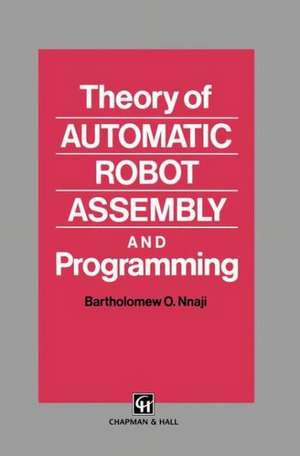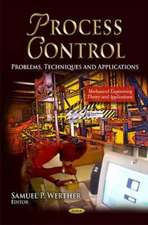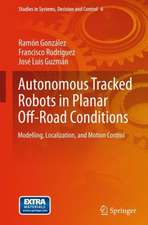Theory of Automatic Robot Assembly and Programming
Autor B.O. Nnajien Limba Engleză Hardback – 31 dec 1992
| Toate formatele și edițiile | Preț | Express |
|---|---|---|
| Paperback (1) | 945.92 lei 6-8 săpt. | |
| SPRINGER NETHERLANDS – 24 sep 2012 | 945.92 lei 6-8 săpt. | |
| Hardback (1) | 952.09 lei 6-8 săpt. | |
| SPRINGER NETHERLANDS – 31 dec 1992 | 952.09 lei 6-8 săpt. |
Preț: 952.09 lei
Preț vechi: 1161.08 lei
-18% Nou
Puncte Express: 1428
Preț estimativ în valută:
182.21€ • 189.52$ • 150.42£
182.21€ • 189.52$ • 150.42£
Carte tipărită la comandă
Livrare economică 15-29 aprilie
Preluare comenzi: 021 569.72.76
Specificații
ISBN-13: 9780412393105
ISBN-10: 0412393107
Pagini: 306
Ilustrații: XVII, 306 p.
Dimensiuni: 155 x 235 x 19 mm
Greutate: 0.64 kg
Ediția:1993
Editura: SPRINGER NETHERLANDS
Colecția Springer
Locul publicării:Dordrecht, Netherlands
ISBN-10: 0412393107
Pagini: 306
Ilustrații: XVII, 306 p.
Dimensiuni: 155 x 235 x 19 mm
Greutate: 0.64 kg
Ediția:1993
Editura: SPRINGER NETHERLANDS
Colecția Springer
Locul publicării:Dordrecht, Netherlands
Public țintă
ResearchCuprins
1 Machine programming.- 1.1 Introduction.- 1.2 Problems of machine reasoning.- 1.3 Robot programming.- 1.4 Machine task-level programming.- 1.5 Organization of this book.- 2 CAD in automatic machine programming.- 2.1 Introduction.- 2.2 Desired CAD data.- 2.3 Feature, feature classification and representation.- 2.4 Feature reasoning for mechanical components.- 3 Spatial relationships.- 3.1 Introduction.- 3.2 Background.- 3.3 Spatial relationships.- 3.4 Product specification attributes.- 3.5 Applications.- 4 Structure of an automatic robot programmer.- 4.1 Introduction.- 4.2 An overview of RALPH.- 4.3 World knowledge database.- 4.4 RALPH commands.- 4.5 Mathematical consideration.- 4.6 Task planner.- 4.7 An example of assembly task.- 4.8 Programming issues.- 4.9 Discussion.- 5 Sensors and representation.- 5.1 Background.- 5.2 Internal and external sensors.- 5.3 Sensor fusion.- 5.4 Sensor architecture.- 5.5 Representation.- 5.6 Probability of sensor usage.- 5.7 Processing.- 6 World modeling and task specification.- 6.1 World modeling.- 6.2 Task specification.- 6.3 Assembly stability model.- 6.4 Designing for stability.- 6.5 Relative stability.- 6.6 Summary.- 7 Gross motion planning and collision avoidance.- 7.1 Introduction.- 7.2 Gross motion in RALPH.- 7.3 Robot motion planning problems.- 7.4 The path planning algorithm.- 7.5 Discussion.- 7.6 Summary.- 8 Grasp planning.- 8.1 Introduction.- 8.2 Background.- 8.3 World spatial relationships in grasping.- 8.4 Grasping concepts.- 8.5 Design and implementation.- 8.6 Summary.- 9 Trajectory planning and control.- 9.1 Introduction.- 9.2 Evaluation of trajectories.- 9.3 Other trajectory evaluation approaches.- 9.4 Background material.- 9.5 Robots with more than 3 degrees of freedom.- 9.6 Evaluation and analysis.- 9.7 Summary.- 10 Considerations for generic kinematic structures.- 10.1 Introduction.- 10.2 Kinematic structures.- 10.3 Kinematic implementation.- 10.4 Kinematic analysis.- 10.5 Example.- 10.6 Pattern of kinematic behavior.- 10.7 Summary.- 11 Program synthesis and other planners.- 11.1 Introduction.- 11.2 Spanning vector for assembly directions and other applications.- 11.3 Precedence generation.- 11.4 Fine motion planning.- 11.5 Program synthesis.- References.
Recenzii
This book is appropriate for a course in robot programming, machine programming and robotic assembly. It can also serve as a major part of a course in robotics or any other automated manufacturing course. - Inspec - The Institute of Electrical Engineers; The material is well laid out and presented in a logical fashion...For any serious worker in assembly, either in an industrial context or as an academic researcher, this book will be extremely valuable. - Int.J.Prod.Res.

















